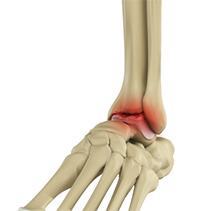Ankle Arthritis

Arthritis is inflammation resulting from the degeneration of cartilage surrounding joints of bones causing pain, swelling and stiffness, and restricted movement. Arthritis of the foot and ankle joint can occur due to fracture, dislocation, wear and tear associated with aging, or autoimmune disease .The foot joints most commonly affected by arthritis are:
- Joint between the shin bone (tibia) and ankle bone (talus)
- Heel bone, inner mid-foot bone and outer mid-foot bone
- Joint of the great toe and foot bone
There are three types of arthritis affecting the foot and ankle:
Osteoarthritis: Also called degenerative joint disease, this is the most common type of arthritis, which occurs most often in older people. With osteoarthritis, the cartilage starts to wear away over time, and can completely wear away, leaving nothing to protect the bones in a joint, causing bone-on-bone contact. Bones may also bulge, or stick out at the end of a joint, called a bone spur.
Rheumatoid Arthritis: This is an auto-immune disease in which the body’s immune system (the body’s way of fighting infection) attacks healthy joints, tissues and organs. It can cause pain, stiffness, swelling and loss of function in joints. Rheumatoid arthritis often begins in feet and ankle and tends to be symmetrical.
Post-traumatic Arthritis: Arthritis developing following an injury to the ankle or foot is called as post-traumatic arthritis. The condition may develop after trauma such as a fracture, severe sprain or ligament tears.
Rheumatoid arthritis is often caused when the genes responsible for the disease are triggered by infection or any environmental factors. With this trigger, the body produces antibodies (defence mechanism) against the joint, causing arthritis. Fractures at joint surfaces and joint dislocations may predispose an individual to develop post-traumatic arthritis. It is considered that your body secretes certain hormones following injury which may cause death of the cartilage cells. Uric acid crystal build-up is the cause of gout and long-term crystal build-up in the joints may cause deformity.
Symptoms of foot and ankle arthritis include pain or tenderness, swelling, and stiffness in the joint and limited range of motion.
The diagnosis of foot and ankle arthritis is made with a medical history, physical examination. X-rays of the affected joint, a bone scan, computed tomography (CT) scans, magnetic resonance imaging (MRI) scans and blood tests are also performed to diagnose arthritis.
Nonsurgical treatment options for foot and ankle arthritis include medications (anti-inflammatories), injections (steroids), physical therapy, weight loss, orthotics such as pads or arch supports, and canes or braces to support the joints. Surgery may be required to treat foot and ankle arthritis, if your symptoms do not get better with conservative treatments. Surgery performed for arthritis of the foot and ankle includes:
Arthroscopic Surgery: Arthroscopy is a surgical procedure during which the internal structure of a joint is examined for diagnosis and treatment. A small incision is made in the patient’s skin through which a pencil-sized instrument with a small lens and lighting system (arthroscope) is passed to magnify and illuminate the structures of the joint, which can be viewed on a television monitor. Your surgeon can then use probes, forceps, knives and shavers, to clean the joint area of foreign tissue, inflamed tissue or bony outgrowths (spurs).
Arthroplasty or Joint Replacement: In this procedure, your surgeon removes the damaged ankle joint and replaces it with an artificial implant. It is usually performed when the joint is severely damaged.
Arthrodesis (fusion): This procedure involves the fusion of two or more adjacent damaged bones. Pins, screws, rods or plates are surgically inserted to hold the bones together as they fuse. Arthrodesis helps reduce pain by limiting motion at the arthritic joint.

 Menu
Menu




